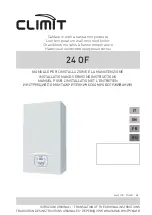
Vitoligno 300-C Installation/Service
5790 980 - 04
12
Boiler Connections
Installation Examples
General
The schematics on the following pages are to be seen as
guidelines only. They further do not display all system
varieties, safety devices, or concepts possible. Specific
system layouts may be further discussed with the local
Viessmann sales representative office.
CAUTION
For underfloor heating applications, an additional
immersion or strap-on aquastat must be installed in the
low temperature underfloor loop (downstream of the
mixing valve) to de-energize the pump and/or boiler to
prevent overheating. High water temperatures can
damage concrete slabs.
WARNING
If a DHW storage tank other than a Viessmann Vitocell
100 or 300 tank is used, the installer must verify proper
operation of the Viessmann DHW tank temperature
sensor with the original manufacturer of the tank.
Viessmann strongly recommends the installation of a
temperature tempering valve in the DHW supply line.
IMPORTANT
The examples on the following pages depict possible
piping layouts of the Vitoligno 300-C boiler equipped
with Viessmann System Technology.
For boiler and tank combinations, please install only
feasible combinations listed in the Viessmann Price List.
Please note that the following examples are simplified
conceptual drawings only!
Piping and necessary componentry must be field verified.
A low water cut-off (LWCO) must be installed where
required by local codes.
Proper installation and functionality in the field is the
responsibility of the heating contractor.
IMPORTANT
DHW supply and return piping between boiler DHW
connections and the Viessmann DHW tank connections,
shall be a minimum of 1¼ in. pipe size. This will ensure
the residual head of the field supplied pump is fully utilized
to overcome the resistance of the DHW heat exchanger
coil and to provide sufficient water flow to the boiler heat
exchanger.
In non-Viessmann DHW tank applications, perform, in
addition to the above, accurate calculations for DHW tank
coil pressure drop versus boiler pump (field supplied)
residual head to ensure sufficient water flow to the boiler
heat exchanger. Failure to heed the above instructions
may cause boiler short-cycling and inadequate DHW
supply.
Clearances
A minimum of 2 in. (51 mm) circumferential clearance from
non-insulated hot water pipes to combustible construction
must be maintained. In cases where the pipes are insulated
with pipe insulation of appropriate and sufficient thickness
and insulation values, the above clearance may be reduced
to 0 in. (0 mm) (refer to local codes).
Note:
In the following piping layout examples all pumps
are field supplied.













































